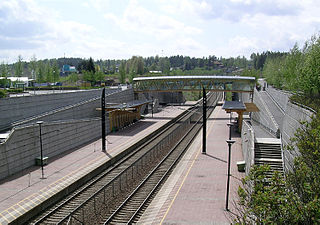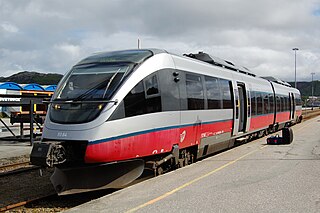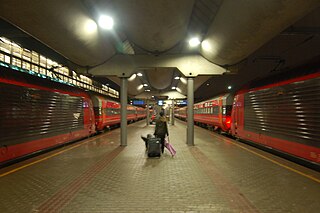
SJ is a government-owned passenger train operator in Sweden. SJ was created in 2001, out of the public transport division of Statens Järnvägar, when the former government agency was divided into six separate government-owned limited companies. In 2018 SJ carried 31.8 million passengers.

The Norwegian railway system comprises 4,109 km of 1,435 mm track of which 2,644 km is electrified and 274 km double track. There are 697 tunnels and 2,760 bridges.

Vygruppen, branded as Vy, is a government-owned railway company which operates most passenger train services and many bus services in Norway. The company is owned by the Norwegian Ministry of Transport. Its sub-brands include Vy Buss coach services, CargoNet freight trains and the Swedish train transport company Tågkompaniet. In 2009, NSB carried 52 million train passengers and 104 million bus passengers. On 24 April 2019, passenger train and bus services were rebranded as Vy.

X 2000, also called SJ X2 or simply as X2, is an electric tilting train operated by SJ in Sweden. It was constructed by Kalmar Verkstad in Kalmar, Sweden and launched in 1990 as a first-class only train with a meal included in the ticket price, and free use of the train's fax machine. There is a bistro on board that serves snack bar-style dishes. From 1995 second class was introduced. All trains are equipped with Wi-Fi for passenger access to the Internet and were repainted grey as of 2005. The trains also have electric power supply sockets at all seats in both first and second class. The trains have been fitted with repeaters to improve mobile phone reception.
Linx AB was a railway company which operated inter-Scandinavian passenger trains between 2001 and 2004. Established as a joint venture between the Norwegian State Railways (NSB) and the Swedish state-owned SJ, Linx operated the routes from Oslo, Norway, to Stockholm, Sweden, and from Oslo via Gothenburg, Sweden, to Copenhagen, Denmark. Services were provided up to ten times per day. However, slow speeds caused by curvy infrastructure in Norway, combined with competition from low-cost airlines, caused the company to lose money, and eventually grounded operations. The services were taken over by NSB and SJ. The main rolling stock were eleven X2 electric multiple units, although it used SJ Rc-hauled trains on the Gothenburg–Oslo service. The company was based in Gothenburg.

The Gardermoen Line is a high-speed railway line between Oslo and Eidsvoll, Norway, running past Lillestrøm and Oslo Airport, Gardermoen. The line is 64 kilometres (40 mi) long and replaced the older Hoved Line as the main line north-east of Oslo. The older Hoved Line now handles commuter and freight traffic, while the Gardermoen Line handles high-speed passenger trains and freight trains laden with jet fuel for the airport. Both lines are owned by Bane NOR.

The Ofoten Line is a 43-kilometre (27 mi) railway line in Narvik, Norway. It runs from the Port of Narvik to Riksgränsen on the Norway–Sweden border, where the line continues as the Ore Line via Kiruna and Gällivare to Luleå. The Ofoten Line is single track, electrified at 15 kV 16.7 Hz AC and has seven stations. The line only connects to the rest of the Norwegian railway network via Sweden. The main traffic is up to 12 daily freight trains operated by Malmtrafik that haul iron ore from Sweden to Narvik. In addition, CargoNet operates container trains, branded as the Arctic Rail Express (ARE), and SJ operates passenger trains, including a night train to Stockholm.

The Kongsvinger Line is a railway line between the towns of Lillestrøm and Kongsvinger in Norway and onwards to Charlottenberg in Sweden. The railway was opened on 3 October 1862 and is Norway's second standard gauge line. It was electrified in 1951. The line is owned by the Norwegian National Rail Administration.

NSB Class 73 is a class of 22 electric multiple units built by Adtranz for the Norwegian State Railways. The four-car trains were modifications of Class 71, which was again based on the Swedish X2. The A-series consists of 16 intercity trains; they were delivered in 1999 and 2000 and are used on the Bergen, Dovre and Sørland Lines. The intercity service was branded as Signatur until 2003. The B-series consists of six regional trains delivered in 2002 and used on the Østfold Line. The regional trains were originally part of the Agenda concept. The trains have a power output of 2,646 kilowatts (3,548 hp) and a maximum speed of 210 km/h (130 mph). They have an overall length of 108 meters (354 ft) and have a capacity for 208 seated passengers in the A-series and 250 in the B-series. The trains have a tilting mechanism allowing for faster travel through curves.

Class 93 is a tilting two-carriage diesel multiple unit used by SJ Norge for passenger trains on non-electrified stretches of the Norwegian railway network. Used on the Nordland Line, the Røros Line and the Rauma Line, they were purchased to replace the aging Di 3 locomotive-hauled trains. The Class 93 was produced by Bombardier, and is part of the Talent family. Fifteen units were delivered between 2000 and 2002.

NSB Class 71 is an electric multiple unit used by Flytoget for the Airport Express Trains on the Gardermoen Line of Norway. Sixteen three-car train sets were built by Adtranz Strømmen between 1997 and 1998. The units are capable of 210 km/h (130 mph), connecting Oslo Central Station and other stations in Metropolitan Oslo to the Oslo Airport, Gardermoen, along Norway's only high-speed railway.

NSB Class 72 is a class of 36 electric multiple units built by AnsaldoBreda for the Norwegian State Railways. Delivered between 2002 and 2005, the four-car units operate on the Oslo Commuter Rail and the Jæren Commuter Rail. The trains have a capacity of 310 passengers and the 2,250 kilowatts (3,020 hp) motors allow a maximum speed of 160 kilometres per hour (99 mph). The trains were ordered in 1997, with original delivery dates in 2001 and 2002. NSB also had an option to buy 40 additional units. The first units were not delivered until 2002, and by 2004, still half the trains were not in use. Faults included rust, too heavy train weight, and signaling problems. After the initial troubles, the Class 72 has been a highly successful train for NSB and well liked by the maintenance workers.

Norske tog Class 92 is a class of 15 diesel multiple units built by Duewag for the Norwegian State Railways (NSB). The two-car trains were delivered in 1984 and 1985, and were put into service on the Røros Line and southern part of the Nordland Line—which later became the Trøndelag Commuter Rail. Later, they also entered service on the Meråker Line as part of the international Mittnabotåget service. Previously, the trains were also used on the Solør Line, further north on the Nordland Line and on the now electrified Arendal Line. In 2000, a unit was involved in the Åsta accident; which killed 19 people. The trains were refurbished in 2005 and 2006, and NSB plans to replace them by around 2019. Each twin unit seats 168 people, is 49.45 meters long and weighs 92 tonnes. The front car is powered with two electric motors, giving a power output of 714 kilowatts (957 hp) and a maximum speed of 140 kilometers per hour (87 mph).

The Iron Ore Line is a 398-kilometre (247 mi) long railway line between Riksgränsen and Boden in Norrbotten County, Sweden, owned by Trafikverket. The line also contains two branches, from Kiruna to Svappavaara and from Gällivare to Koskullskulle. The term is often colloquially used to also include the Ofoten Line, from Riksgränsen to Narvik in Norway, and the northernmost part of the Main Line Through Upper Norrland from Boden to Luleå. The railway from Narvik to Luleå is 473 kilometres (294 mi) long.

Iore, often stylized IORE, is a class of 34 electric locomotives built by Adtranz and its successor Bombardier Transportation for the Swedish mining company LKAB's railway division Malmtrafik. The class is a variation of Adtranz's Octeon modular product platform, thus related to Bombardier's later TRAXX platform. The locomotives haul iron ore freight trains on the Iron Ore Line and Ofoten Line in Sweden and Norway, respectively. The 8,600-tonne 68-car trains are hauled by two single-ended Co′Co′ locomotives, each with a power output of 5,400 kW (7,200 hp). Each operates with 600 kilonewtons tractive effort and has a maximum speed of 80 km/h (50 mph). Delivery of the first series of 18 locomotives was made from 2000 to 2004, and they replaced some of the aging Dm3 and El 15 units. In 2007, eight more vehicles were ordered, with production to be completed by 2011, by which time, another four double units were ordered. These units were scheduled to be delivered from 2013 to 2014.
Ofotbanen Drift AS, trading as Ofotbanen, was a Norwegian passenger and freight railway company. The company operated a fleet of six locomotives, three multiple units, 22 passenger and 48 freight cars. The sole service was the passenger train Unionsexpressen between Oslo and Stockholm; it had previously offered freight haulage on contract.

LKAB Malmtrafik, earlier Malmtrafik i Kiruna AB (MTAB), is a Swedish railway company which operates the iron ore freight trains on the Iron Ore Line and the Ofoten Line. MTAB is a wholly owned subsidiary of the mining company Luossavaara–Kiirunavaara (LKAB). In Norway, operations are handled by the subsidiary Malmtrafikk AS (MTAS). Malmtrafik hauls ore from LKAB's mines in Kiruna, Malmberget and Svappavaara to the ports of Luleå and Narvik, the latter located in Norway. The company owns 28 Iore locomotives and 750 hopper cars. Each train is 68 cars long and weighs 8,600 tonnes, allowing the company to transport 33 million tonnes per year.

Night trains of Norway are night sleeping car services provided by three different operators on four routes; Vy Tog on Oslo - Bergen, Go-Ahead Norge on Oslo - Stavanger, and SJ Norge on Oslo - Trondheim and Trondheim - Bodø.

Vestby Station is a railway station on the Østfold Line located in the village of Vestby, Norway. It is served by commuter trains operated by Vy running from Oslo to Moss. The station opened in 1879, and was modernised in the early 1990s. It features a passenger walkway built in gluelam connecting its two platforms and a small parking lot with place for approximately 120 cars. In 1950 the station served about 160 passengers to Oslo each day. Today the number are 2-3000.

Norway/Vänern Line is a Y-shaped railway line in Sweden. The main section runs from Gothenburg Central Station to Kil Station, mostly along the west shore of Vänern. There is a branch from Erikstad to the Norway–Sweden border at Kornsjø, from where it continues as the Østfold Line to Oslo. The lengths of the line are 112 kilometres (70 mi) from Gothenburg to Erikstad, 180 kilometres (110 mi) from Gothenburg to Kornsjø and 232 kilometres (144 mi) from Gothenburg to Kil. The line is single track, except for the 82 kilometres (51 mi) section from Gothenburg to Öxnered, which is double track.



















